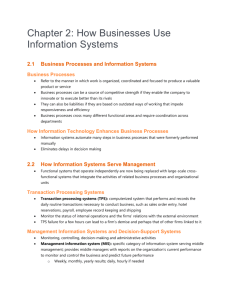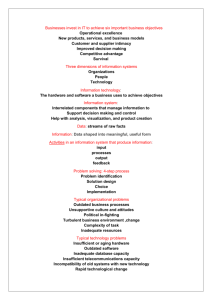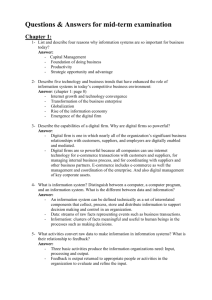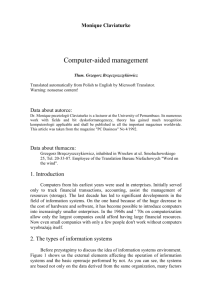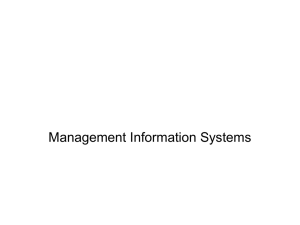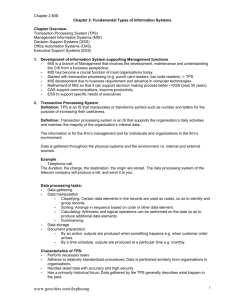MIS - WordPress.com
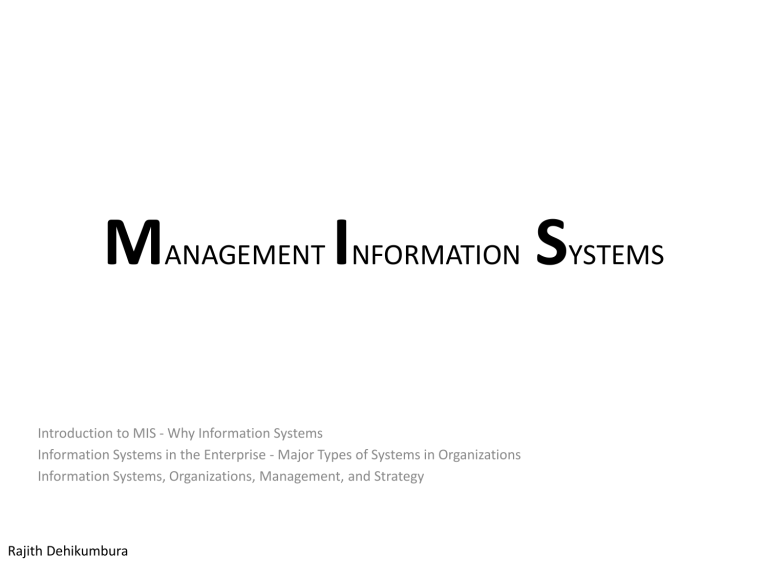
M
ANAGEMENT
I
NFORMATION
S
YSTEMS
Introduction to MIS - Why Information Systems
Information Systems in the Enterprise - Major Types of Systems in Organizations
Information Systems, Organizations, Management, and Strategy
Rajith Dehikumbura
Introduction to MIS - Why
Information Systems
Data vs. Information
• Data: Streams of raw facts representing events occurring in organizations or the physical environment before they have been organized and arranged into a form that people can understand and use.
• Information: Data that have been shaped into a form that is meaningful and useful to human beings.
What Is an Information System?
• An information system can be defined technically as a set of interrelated components that collect (or retrieve), process , store , and distribute information to support decision making and control in an organization. In addition to supporting decision making, coordination, and control, information systems may also help managers and workers analyze problems, visualize complex subjects, and create new products.
Why Information Systems?
• Changed the operation of firms, industries, and markets rapidly
1. Capital Management
2. Foundation of Doing Business
3. Productivity
4. Strategic Opportunity and Advantage
Capital Management
• Information technology (hardware, software, and telecommunications equipment) has become the largest component of capital investment for firms today. As managers, you will certainly want to know how to invest money wisely for Information Technology. If you make wise choices, your firm can outperform competitors. If you make poor choices, you will be wasting valuable capital
Foundation of Doing Business
• Today a bigger part of the employ force in the world relies on information systems every day to conduct business.
• All of e-commerce, finance, insurance, real estate as well as personal services such as travel, medicine, and education could not operate without IT
• Information technology is a foundation for business in the twenty-first century
Productivity
• IT is one of the most important tools for achieving significant gains in productivity along with innovations in organization and management. Investment in IT plays a critical role in increasing the productivity of firms.
Firms that invest wisely in information technology will experience continued growth in productivity and efficiency
Strategic Opportunity and Advantage
• If you want to take advantage of new opportunities in markets, develop new products, and create new services, you will need to make substantial investments in IT. If you want to achieve a strategic advantage over your rivals, to differentiate yourself from your competitors, IT is one of the best tools you can use along with changes in business practices and management.
Dimensions of Information Systems
• Organizations, Management, Technology
Organizations
• Information systems are an integral part of organizations
• The key elements of an organization are its people, structure, business processes, politics, and culture
• The major business functions, or specialized tasks performed by business organizations, consist of sales and marketing, manufacturing and production, finance and accounting, and human resources
• Most organizations’ business processes include formal rules set
• Most of these business processes can be incorporated into information systems
Management
• The Management’s job is to make decisions, and formulate action plans to solve organizational problems
• Managers must also create new products and services and even re-create the organization from time to time
• This requires creative work driven by new knowledge and information
• This is where information technology plays a vital role
Technology
• Information technology is one of many tools managers use which consists of
– Hardware
– Software
– Storage
– Communication devices
Information Systems in the Enterprise
- Major Types of Systems in
Organizations
Main categories of information systems
• No single system can provide all the information an organization needs
• Systems are built to serve these different organizational interests
• There are three main categories of IS
1. Operational-level systems
2. Management-level systems
3. Strategic-level systems
Operational-level systems
• Support operational managers
• Keep track of the elementary activities and transactions of the organization, such as sales, receipts, cash deposits, payroll, credit decisions, and the flow of materials in a factory.
• The principal purpose of systems at this level is to answer routine questions and to track the flow of transactions through the organization.
• Examples:
• How many parts are in inventory?
• What happened to Mr. Saman’s payment?
• To answer these kinds of questions, information must be easily available, up to date, and accurate .
• Examples of operational-level systems one that tracks the number of hours worked each day by employees on a factory floor
Management-level systems
• Serve the monitoring, controlling, decision-making, and administrative activities of middle managers
• The principal question addressed by such systems is this: Are things working well?
• Management-level systems typically provide periodic reports rather than instant information on operations.
• An example is a production level monitoring system in a production line with graphs of material consumed and the output
• Management-level systems support non-routine decision making
• These systems often answer “what-if” questions: What would be the impact on production schedules if we were to double sales in the month of December? What would happen to our return on investment if a factory schedule were delayed for six months? Answers to these questions frequently require new data from outside the organization, as well as data from inside that cannot be easily drawn from existing operational-level systems
Strategic-level systems
• Help senior management to address strategic issues and long-term trends, both in the firm and in the external environment.
• Their principal concern is matching changes in the external environment with existing organizational capability.
• What will be the employment levels in five years?
What are the long-term industry cost trends, and where does our firm fit in? What products should we be making in five years?
• A strategic level system usually use forecasting trends over a time
Major types of systems
• There are four specific types of information systems that correspond to each organizational level
1. Executive support systems (ESS) Strategic level
2. Management information systems (MIS) Management level
3. Decision-support systems (DSS) Management level
4. Transaction processing systems (TPS) Operational level
Transaction Processing Systems
• Basic business systems that serve the operational level
• Computerized systems that performs and records the daily routine transactions necessary to conduct business.
• Examples are sales order entry, hotel reservation systems, payroll, employee record keeping, and shipping.
• Transaction processing systems are often so central to a business that TPS failure for a few hours can lead to a disaster in a firm and perhaps that of other firms linked to it. Example : The (UPS) package tracking system
• TPS are also major producers of information for the other types of systems . (For example, the payroll system along with other accounting TPS, supplies data to the company’s general ledger system, which is responsible for maintaining records of the firm’s income and expenses and for producing reports such as income statements and balance sheets.)
Management Information Systems
• Management information systems (MIS) serve the management level of the organization, providing managers with reports and often online access to the organization’s current performance and historical records
• Typically, MIS deals with internal, not environmental or external , events.
• MIS primarily serve the functions of planning, controlling, and decision making at the management level. Generally, they depend on underlying transaction processing systems for their data.
• MIS summarize and report on the company’s basic operations.
• The basic data from TPS are compressed and are usually presented in long weekly, monthly, and yearly reports.
• These systems are generally not flexible and have little analytical capability .
• Most MIS use simple routines such as summaries and comparisons, but not any sophisticated mathematical models or statistical techniques.
Decision Support Systems
• Decision-support systems (DSS) also serve the management level of the organization.
• DSS help managers make decisions that are unique, rapidly changing , and not easily specified in advance
• They address problems where the procedure for arriving at a solution may not be fully predefined in advance. Although DSS use internal information from TPS and MIS, they often bring in information from external sources , such as current stock prices or product prices of competitors.
• Clearly, by design, DSS have more analytical power than other systems. They use a variety of models to analyze data
• DSS include user-friendly software. DSS are interactive ; the user can change assumptions, ask new questions, and include new data.
Executive Support Systems
• Senior managers use executive support systems (ESS) to help them make decisions.
• ESS serves the strategic level of the organization.
• They address non routine decisions requiring judgment, evaluation, and insight which have no agreed-on procedure for arriving at a solution.
• ESS is designed to incorporate data about external events, such as new tax laws or competitors, but they also draw summarized information from internal MIS and DSS.
• They filter, compress, and track critical data, displaying the data of greatest importance to senior managers.
• ESS has the most advanced graphics software and can present graphs and data from many sources.
• Unlike the other types of information systems, ESS is not designed primarily to solve specific problems . Instead, ESS provides a generalized computing and communications capacity. Although many DSS are designed to be highly analytical; ESS tends to make less use of analytical models.
• ESS assist senior managers to answer the following questions: In what business should we be? What are the competitors doing? What new acquisitions would protect us from cyclical business swings? Which units should we sell to raise cash for acquisitions?
Information Systems, Organizations,
Management, and Strategy
What is an Organization?
• An organization is a stable, formal social structure that takes resources from the environment and processes them to produce outputs.
• Capital and labor are primary production factors provided by the environment. The organization (the firm) transforms these inputs into products and services in a production function.
• The products and services are consumed by environments in return for supply inputs.
• Organizations are formal legal entities with internal rules and procedures, which must abide by laws.
Organizations also have a structure.
Common Features of Organizations
• You might not think that Apple Computer, United Airlines, and the Sri
Lanka Railway department have much in common, but they do. In some respects, all modern organizations are alike because they share common characteristics
Organizations and Information Systems
• Information systems and organizations influence one another
• Information systems are built by managers to serve the interests of the business firm
• At the same time, the organization must be open to the influences of information systems to benefit from new technologies
• The interaction between information technology and organizations is complex and is influenced by many mediating factors, including the organization’s structure, standard operating procedures, politics, culture, surrounding environment, and management decisions
• As a manager, you will need to understand how information systems can change social and work life in your firm. You will not be able to design new systems successfully or understand existing systems without understanding your own business organization
• As a manager, you will be the one to decide which systems will be built, what they will do, and how they will be implemented. Some of the changes that occur in business firms because of new information technology (IT) investments cannot be foreseen and have results that may or may not meet your expectations
Organizing the IT Function
• There are many ways in which the IT function is organized within the firm.
In the typical firm the unit responsible for information technology services is called the information systems department
• This department is responsible for maintaining the hardware, software, data storage, and networks that comprise the firm’s IT infrastructure
• This department consists of specialists, such as programmers, systems analysts, project leaders, and information systems managers
• Programmers are highly trained technical specialists who write the software instructions for computers
• Systems analysts communicate between the information systems groups and the rest of the organization. They translate business problems and requirements into information requirements and systems
• Information systems managers are leaders of teams of programmers and analysts, project managers and data entry staff
• External specialists, such as hardware vendors and manufacturers, software firms, and consultants frequently participate in the day-to-day operations and long-term planning of information systems
Organizing the IT Function
• The information systems department is headed by a chief information officer (CIO)
• CIO oversees the use of information technology in the firm
• Today, the information systems department acts as a powerful change agent in the organization. The information systems department suggests new business strategies and new information-based products and services
• In the past, firms generally built their own software and managed their own computing facilities. Today, many firms are turning to external vendors to provide these services and are using their information systems departments to manage these service providers
